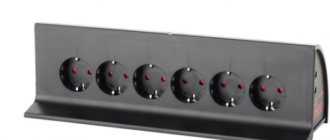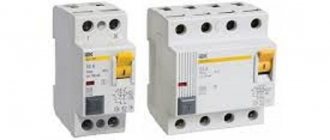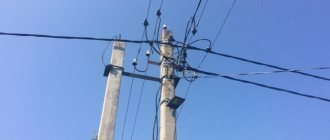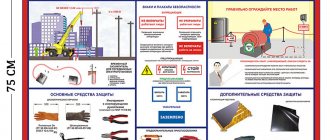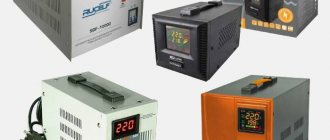Network overvoltage concept
Different sources provide different definitions of “overvoltage” in a network. Here is the definition of this concept given by Wikipedia:
The Nautical Dictionary defines overvoltage as an increase in voltage in power lines and electrical networks to such a level that it may damage the insulation.
According to GOST R 54130-2010, overvoltage is the excess of the highest operating voltage, which is set for a given type of electrical equipment.
The Russian Encyclopedia of Occupational Safety defines overvoltage as a significant voltage of a conductor relative to the ground, which can significantly exceed the phase voltage as a result of internal or atmospheric phenomena
Characteristics of overvoltage in the electrical network
In general, overvoltage can be considered any significant increase in voltage in the network caused by various reasons. Voltage drops can have different amplitudes, durations and frequency.
The main characteristics of overvoltage include:
- peak voltage value
- overvoltage repetition rate
- time of the rise period of the overvoltage value
- area or length of overvoltage propagation in the network
- total number of surges over a period of time
- total time of the entire overvoltage cycle
Protection measures
The electrical network must always be reliable, comply with the above-mentioned GOST for the quality of power supply and have protective devices against possible overvoltages (especially in areas of increased lightning danger). It is impossible to completely avoid pulse overvoltages, but you can reduce their magnitude to a relatively safe level (modern equipment is manufactured with a certain voltage reserve).
To protect the electrical network and appliances at home, you must:
- install lightning protection (if there is none nearby) - lightning rod;
- install an SPD - a special protection device that reduces dangerous surge voltage;
- install an RCD and a voltage relay in the power supply panel.
We talked in more detail about surge protection devices in the corresponding article, which we strongly recommend that you read!
Important! Don’t know who pays for the damage when electrical appliances burn out? The energy supply company is fully responsible for the quality of voltage in the network. Therefore, first of all, you should go there and write a statement indicating the losses caused. However, before this you should obtain documents proving the causes of damage (reports with witnesses, photos with the date of shooting, control measurements of high or low voltages by calling a competent electrician with a special device). You must also refer to the above GOSTs.
So we looked at what overvoltage in the network is, what are the reasons for its occurrence and how to protect yourself from this phenomenon at home. We hope you found the information provided useful!
Source
Types of overvoltage in the electrical network
In general, according to the method of formation, internal (or switching) and external (lightning or atmospheric) overvoltages are distinguished
There are the following main types of overvoltage in the electrical network:
- lightning surges
- inductive overvoltages
- quasi-stationary overvoltages
- switching overvoltages
Main reasons
Since external factors of influence have already been considered, let’s immediately move on to the internal reasons that cause an increase in voltage, starting in order. Switching factors:
- Abrupt load shedding when protective devices are triggered, for example, air circuit breakers, creates strong interference, especially during an emergency shutdown of power lines.
- Switching of capacitor units.
- Turning off powerful electrical machines and power transformers (causes the impact of inductive currents on the line).
- Reswitching of lines.
An example of typical switching voltage deviation is marked in blue in the graph below.
Typical switching overvoltage
Quasi-stationary deviations can be caused by the following factors:
- Regime , these include:
- asymmetrical short circuit to earth in a network with an isolated neutral;
- arc faults in lines with voltage 6.0-35.0 kV (arc overvoltage);
- acceleration of the generating set due to sudden load shedding;
- incorrect phasing of transformer installations;
- other unfavorable combinations of EMF in the electrical network.
- Resonant overvoltages . They arise when the frequencies of the forced EMF and a separate section of the network are close to coincidence. If this happens, the "capacitive effect" will result in overvoltage.
In the case when the line operates in open-phase mode and a transformer with a grounded neutral is connected to it, there is a high probability of the formation of a resonant circuit. The interaction will occur between the inductance of the transformer installation and the interphase capacitance and will also cause a high overvoltage factor.
- Ferroresonance overvoltage . This type of deviation can be observed during the formation of a resonant oscillatory circuit that meets the following conditions:
- frequency is close to 50.0 Hz;
- lower and higher harmonics occur;
- the inductive component has a saturated magnetic circuit.
In the open-phase operating mode of the system, the effect of ferroresonance is possible in circuits where there is inductance formed by transformers connected in series.
Quasi-stationary overvoltage in the network
Quasi-stationary overvoltages in the network can last from several seconds to several minutes. Such overvoltages are dangerous for equipment connected to the network.
Quasi-stationary overvoltages occur for the following reasons:
- the appearance of dangerous resonance in the electrical network
- in case of short circuits in the network
- during an emergency increase in the speed of the electric generator in the event of a sharp drop in the load value in the network
- when the ferroresonance effect appears in networks with powerful inductive coils or magnetic cores
Emergency breaks in networks
A frequent type of accident in networks is the so-called “zero break”, in other words, the break of the neutral conductor in a three-phase power network.
A phenomenon called “phase imbalance” occurs, since the voltage is redistributed depending on the phase load.
Such emergency situations most often occur on transformers that do not have appropriate compensating equipment.
Electrostatic factors of power supply overvoltage
There are materials that can accumulate and retain electrical charge. This property is greatly enhanced in dry air. Such electrostatic potentials are not felt until a discharge occurs.
A discharge occurs completely unexpectedly if you accidentally touch pipes or heating radiators, or metal parts of equipment connected to the electrical network.
You can accumulate an electrostatic potential of several thousand volts if you walk on carpeted floors in dielectric shoes.
When you touch the body of equipment connected to the network, for example, a computer case, a discharge lasting several nanoseconds will occur.
This discharge may be enough to damage some electronic parts of your computer.
Network surge protection
The responsibility for protecting electrical networks from natural and man-made factors lies with the organizations servicing these networks. Equipment for lightning protection and protection against voltage surges in high-voltage networks is installed on transmission line supports and masts, and at electrical substations of all levels. Network protection equipment is also installed at substations of factories and factories, power substations for powering electric transport networks.
To protect the electrical equipment of the house and household electrical appliances in private houses and apartments, local devices can be installed to protect against voltage surges and surges.
manufactures a line of surge and surge protection devices. More information about these devices can be found in the “Power Surge Protection” section.
All voltage protection devices comply with the requirements of Russian and international standards.
Albatross surge and surge protection devices will reliably protect your network, electrical equipment and household appliances from the harmful effects of power surges and surges.
Voltage stabilizers and UPS
Stabilizers are more powerful analogues of network filters: they provide protection against voltage surges and short circuits, and “cleanse” high-frequency interference. Powerful stabilizers are installed for the entire network - most often they are installed in private houses, country cottages, that is, where the electrical network is characterized by voltage instability. Less powerful models can be installed to protect a single device - for example, an expensive refrigerator that is sensitive to the quality of current.
In electrical networks with a voltage of 220 V, single-phase stabilizers are installed. For 380 V networks, a three-phase or three single-phase stabilizers are needed.
Surge suppressors. The surge arresters are compact in size and are most often used in individual homes. Their design includes a varistor. When there is a voltage drop, a nonlinear resistor shunts the resulting load and reduces the resistance value.
Overvoltage sensors. DPN is used in combination with a circuit breaker or residual current device (RCD). After such a sensor detects excess voltage, the RCD opens the circuit.
Uninterruptible power supplies. UPSs are combined devices: they combine a stabilizer and a surge protector. Can be redundant, double-converted or interactive.
In standby mode, the current passes through the LC circuit. Thanks to the presence of a built-in battery, they ensure stable operation of electrical consumers during a power outage. The disadvantage of this type of UPS is the delay when switching to batteries, which can be up to 15 milliseconds.
A double conversion UPS converts alternating current into direct current. At the output for electrical consumers, alternating current with the required voltage is again supplied. The device's batteries are constantly connected to the network. “Uninterruptible power supplies” of this type are the most expensive, and they heat up more. Most often, such UPSs are used for medical equipment, servers and other equipment that is particularly demanding on power reliability.
Interactive “uninterruptible power supplies” are devices equipped with a step stabilizer that maintains the required voltage without the use of batteries, which significantly extends their service life. Such UPSs are suitable for computers and household appliances.

